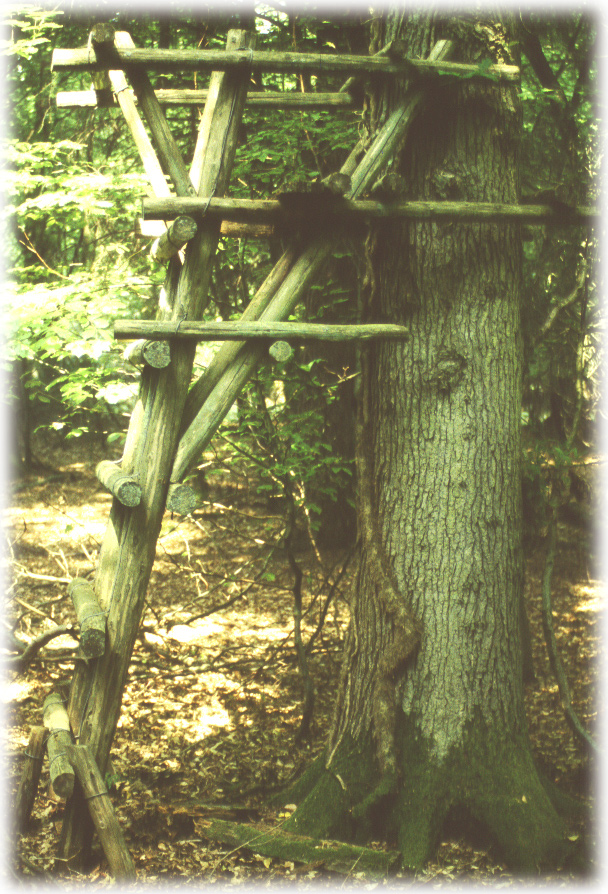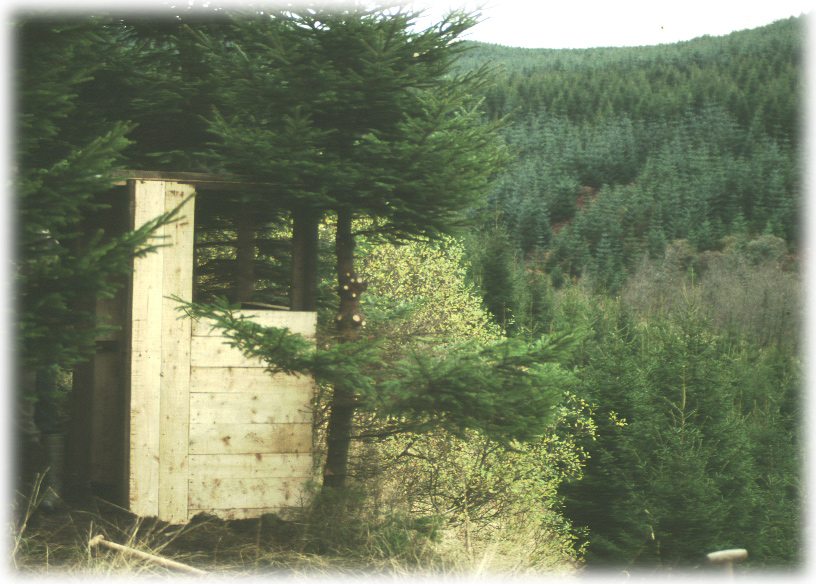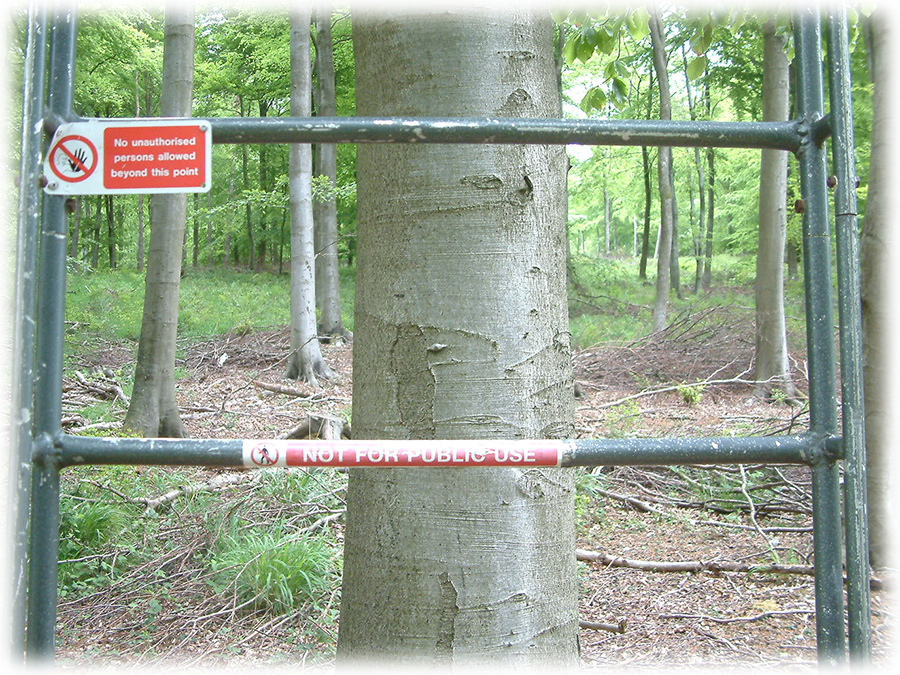
wooden high seat
Introduction
This guide describes the types, siting and use of high seats for deer management.
Uses of high seats
Natural features are often used as vantage points from which to view or shoot deer. Where these are not available a high seat can be used. Typical situations are:
- Flat or domed areas where either sighting of deer or provision of a safe backstop is difficult.
- In situations where waiting for deer is more effective than stalking on foot.
- Overlooking vulnerable crops or conservation sites.
- Overlooking areas where deer emerge from cover, such as woodland edges and rides.
- Overlooking deer transit areas or crossing points.
- Overlooking areas where there is high vegetation e.g. bracken in mid summer or pre-thicket forestry plantations
- Where a high seat is used to restrict shooting to known safe areas.
Types of high seat
Purchased high seats are usually constructed from steel or aluminium, each with it’s own strength and weight advantages. Home made seats are commonly made from timber.
A seat may be essentially permanent, semi portable or truly portable, designed to be moved either regularly or at each use.
The types of high seat, together with some typical situations of use are described in the table below.
| Type | lean-to (including self-climbing high seats)‡ | free-standing | deer hide or doe box |
|---|---|---|---|
| Construction | Lean-to seats are set up against a structure such as a mature tree, and securely fastened by ropes or straps. Metal or wood. Can be either portable or permanent. | Stands alone supported on its own integral legs. Metal or wood. Usually permanent, may be semi-portable. | A fixed box or shooting platform/rail. More easily blends into the surrounding forest area making it visually unobtrusive. Permanent. Easy and safe to access. |
| Location | Often used on the edge of mature woodland or in glades, where a suitable tree is available. | Best used in areas where there is no support for a lean-to, to ensure the optimum vantage point. | Best situated on a vantage point overlooking the control area. |
| Disadvantages | Use limited to where a suitable, stable support can be found. The supporting tree may sway in high winds. The type most vulnerable to theft. | Must be secure as a structure and requires a stable, firm, level base. Not so easily moved. | Restricted to suitable vantage points. Not so easily moved. |
| Cost | Less expensive to purchase or construct than free standing seats. | More expensive than the lean-to design. | Relatively cheap to construct. |
‡The ‘self–climbing’ high seat is a light-weight, portable and quickly assembled system which allows the stalker to ‘walk’ up a suitable tree.
When choosing or designing a high seat consider these additional points:
- How long is the structure likely to remain safe, for instance some wooden seats may have a working life of only a few years.
- How easy/safe will it be to access the seating area when climbing the seat
- The position of the rails, many rails are too close to the seat for comfortable shooting
- The distance between rungs. Particularly on home made seats do not place the rungs more than about 30 centimetres apart.
- How comfortable the seat is and if it allows the user to turn to shoot from the sides/back.
- How easy it will be to transport and erect.
- Most high seats do not need to be more than 4 metres from the ground to the seat.

doe box under construction
Portable versus permanent
The advantages of portable aluminium/steel high seats are:
- can be dismantled/folded for transportation;
- can easily be erected by a single person;
- a number of different sites can be covered in a season;
- potential sites for permanent structures can be trialled for suitability.
Some disadvantages are:
- some designs may not be particularly robust
- can be expensive
- can be prone to theft
- can be too short for some sites
- Where control is envisaged over an extended period, a permanent type may be the most appropriate.
Siting
Consider the following when deciding where to site a high seat:
- Ensure that deer are likely to use the overlooked area and that a seat is necessary;
- On some sites the growth/rotation of crops or growth of ground cover may limit the choice of seat to a portable type.
- Position the seat so as to maximise the safe background available. Where possible provide for a stable shooting position in as wide an arc of fire as possible. It may be advisable to mark out safe shooting areas;
- It can be useful to mark out a known shooting distance for reference by users:
- Where possible, use natural features to help make the seat and its approach route less visible. It is not usually necessary to artificially camouflage high seats unless they are particularly exposed. Avoid siting on sky-lines. High visibility may draw unwelcome human attention to the seat;
- Avoid facing the seat in a direction where the sun , low on the horizon, might reduce visibility;
- The direction of the prevailing wind. Ideally, chose sites where human scent will not usually be blown, either from the seat or its approach routes, over the control area;
- Over time, shrub and tree growth might reduce the available shooting area, be prepared to clear and maintain sight lines;
- In woodland situations consider clearing a route over the last 50 metres or so to allow a silent approach;
- Locate away from known routes of public access where possible;
- Planning permission is not required if a high seat is associated with forestry or agricultural protection. Always obtain permission from a landowner before erecting.
Maintenance
- Carry out a formal inspection annually and record results (consider numbering seats for the record). Carry out and record any maintenance work necessary before use.
- When erecting/removing high seats, critical times to take extra care are when lifting the seat from transportation, raising/lowering the seat, and whilst fastening/detaching a lean-to seat to it’s support.
- Fasten lean-to seats securely to the support, by either ropes or a ratchet belt. Do not nail or screw directly to trees. In situations where theft is likely secure with a chain and padlock.
- Construct wooden high seats from a strong straight grained wood such as treated Larch. Ensure that the rungs are securely fixed and incorporate wire or metal rod reinforcement in case of breakage. Consider placing small mesh wire across the rung, to provide sure footing in wet conditions.
- Do not paint the ladder if this would cover up dangerous cracks in wood or untreated rust patches.
- When constructing a floor area ensure that boards are heavy enough to take the desired weight and are fully supported by cross supports. Treated timber is best for load-bearing timbers.
- Make sure that no part of the structure can move or separate when in use. Moveable shooting rails can be particularly dangerous.
- Remove old seats no longer in use or unsafe.
- Keep a record of high seat locations.
- Where practical prevent unauthorised access by removing the lower section of ladder. If a ladder shroud is fitted it must prevent access along the sides or back of the ladder otherwise it may increase the likelihood of injury rather than reduce it.
- In public areas fix an approved sign indicating that the seat is not for general use.

Use
- Ensure that an appropriate risk assessment has been carried out and recorded where appropriate.
- Follow Health and Safety Authority (HAS) guidance and ensure that activities adhere to the relevant Health & Safety Legislation. Take all reasonable precautions to prevent potential liability for injury resulting from both authorised and unauthorised use of high seats.
- Approach and leave seats quietly. Try to avoid making non-target deer aware of your presence while using the seat.
- Carry out a quick check that the high seat is safe and fit-for-purpose immediately before use.
- When climbing keep a minimum of three points of contact on the ladder, between hands and feet. Carry the minimum of equipment up the seat.
- Ensure that there are no rounds in the chamber of the firearm when climbing up and down the high seat. Only chamber a round once stable in the seat.
- When two people are using a double high seat only one person should climb or descend the ladder at a time.
- When two people are using a double high seat ensure that the status of all firearms present has been checked and confirmed between parties at all stages.
- Ensure that the rifle and other equipment cannot fall from the seat.
- Once settled scan the entire area for dangers, then for deer that are already present.
- Decide on the available safe backdrops and do not compromise by taking shots elsewhere.
- When shooting ensure a stable shot by using all available support, including the side rails, rather than shooting with the rifle only balanced on a single rail. Ensure that there is some form of cushioning (e.g. a hand) between the rail and the rifle, and that the barrel is not in contact with any part of the structure.
- When taking shots at less than 25 metres allow for the fact that the angle of the bullet path could be very steep and the rifle will shoot low (see Firearms and Ammunition guide).
- If using a dog, ensure that it is secured safely where it will not be injured should something fall from the seat.
Be aware of the dangers of falling asleep and hypothermia.
Further Info
- Safety, Health and Welfare at Work Acts 2005 and 2010
- Guide to the Safety, Health and Welfare at Work (General Application) Regulations 2007. Part 4 – Work at Height.
- Using Ladders Safely – HAS Information Sheet
You can find these and other regulations at the Health and Safety Authority website www.hsa.ie
[printfriendly]